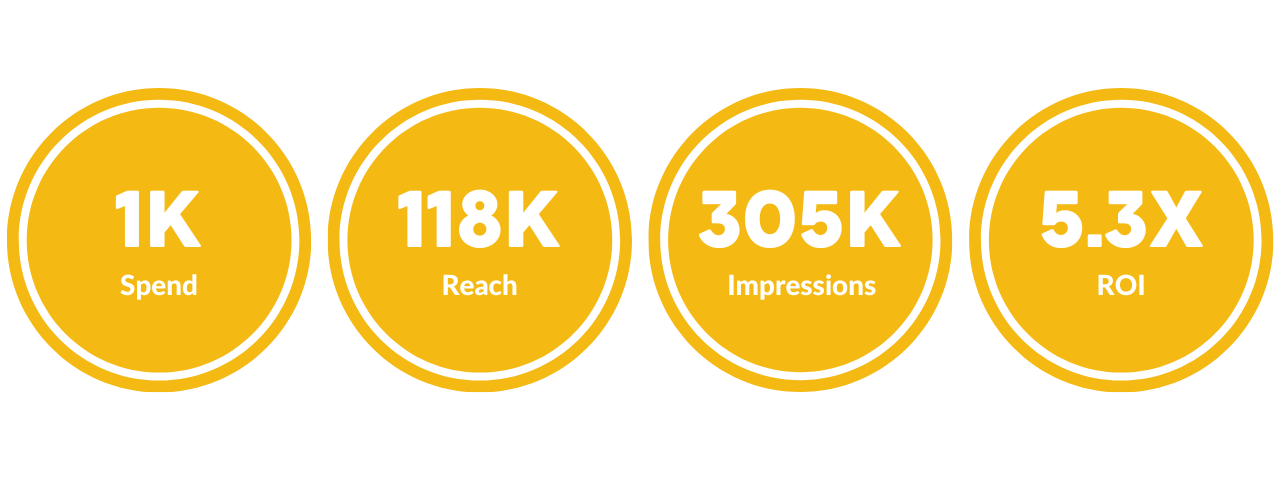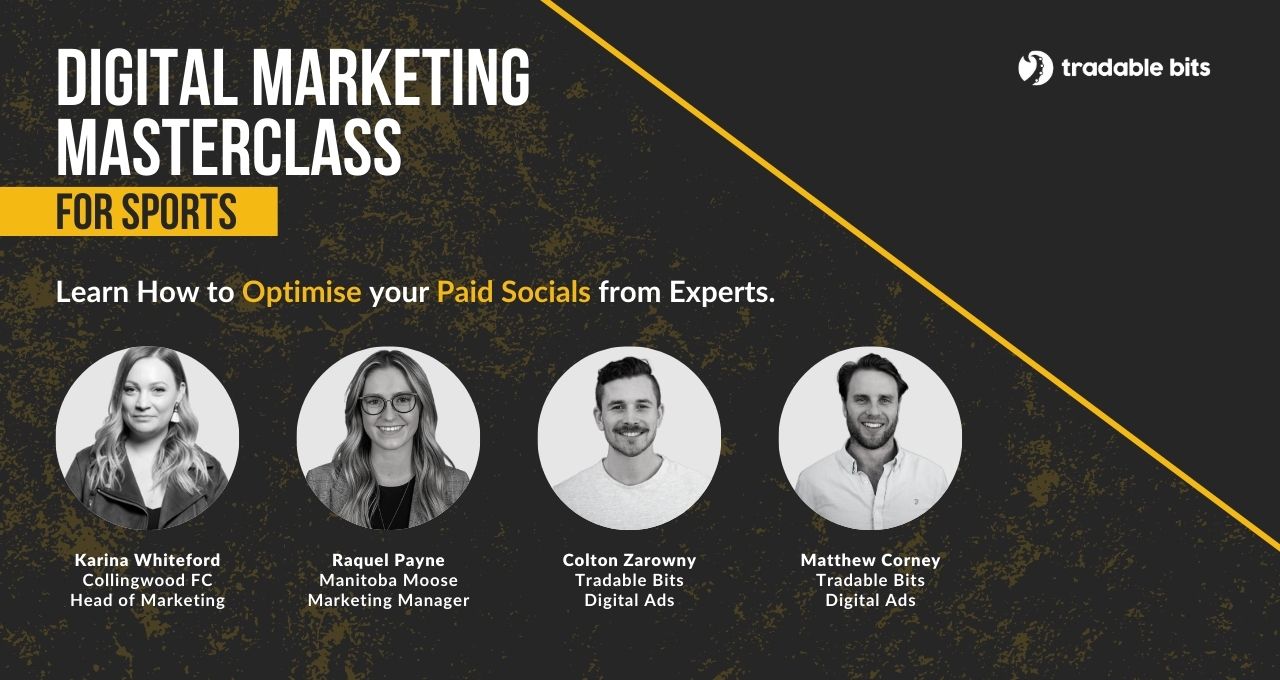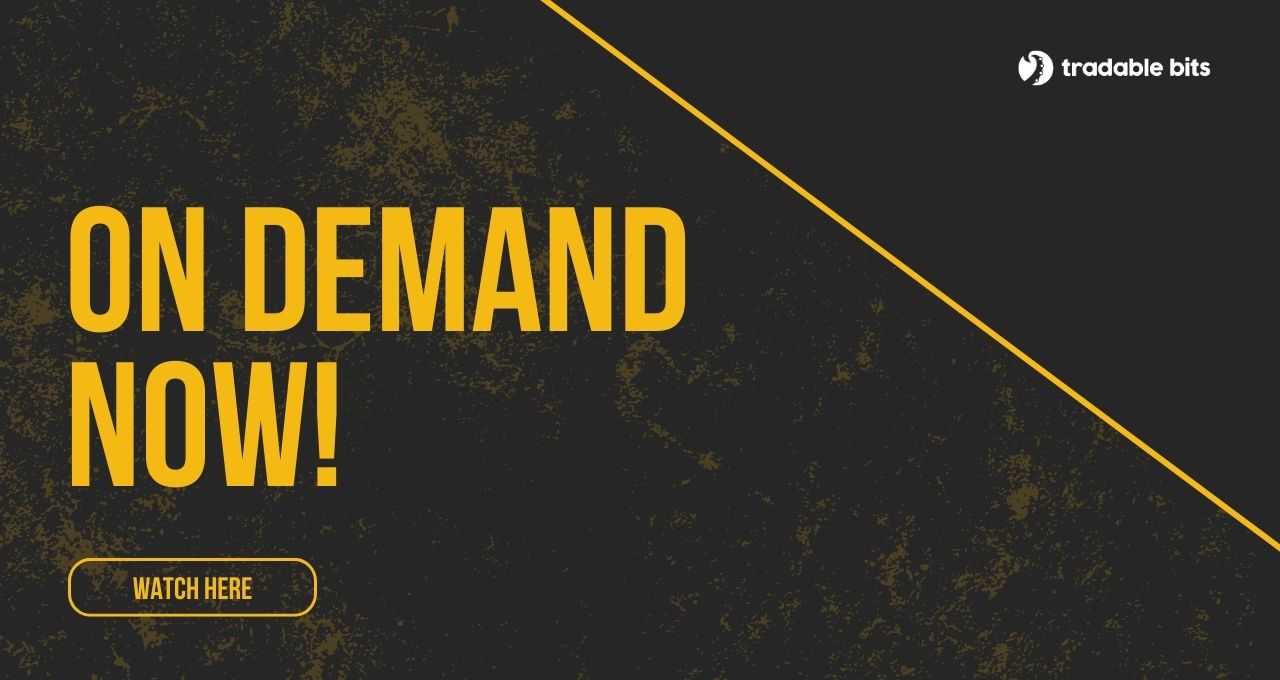How many hats do you presume the average Sports Marketer wears? One? Six? A dozen?
We’ll bet that whatever number you chose, it will just keep going up as more roles and responsibilities get tagged onto the all-encompassing “Marketing Director/Manager” role. Which is why we’re so impressed with the work of our partners - Karina Whiteford from Collingwood Football Club and Raquel Payne at TNSE - who are able to juggle a thousand things while pulling off highly successful Advertising Programs.
What makes a successful advertising program? How does a small team vs large team react to the same challenge? What are the tips & tricks that can shave months off your “experimentation” phase? Karina and Raquel share all that and more in our interview. Spoiler alert - it all comes down to using data to personalize and define who your fans are & what they want to hear from you.
Karina Whiteford is the Head of Marketing at Collingwood Football Club, a professional Australian rules football club based in Melbourne that competes in the AFL. Connection, joy and happiness fuel her approach to fan marketing.
Raquel Payne is the Marketing Manager at Manitoba Moose Hockey Club, a professional ice hockey team based in Winnipeg that competes in the American Hockey League. She thrives in an all-encompassing environment.
DIGITAL MARKETING TRENDS
IF YOU WANT YOUR FANS TO PAY ATTENTION, BRING YOUR MESSAGING TO THEM. DON’T MAKE THEM SEEK IT OUT.
Raquel: When it comes to digital marketing, it’s important that we’re finding and delivering our ads and messaging directly to where our fans and consumers are taking in that information. Paid social is a huge part of that. Very few people aren’t scrolling on their phones most of the day, so it’s more about bringing that messaging to them than having them seek it out.
On our side, we’re also trying to communicate more of that atmosphere and those experiences vs just the one hockey game. We’re selling more of that full-body entertainment experience - and by doing that - we’re finding more ways to have fun with our messaging, and the form of how we deliver this messaging.
DIGITAL MARKETING IS NO LONGER JUST ABOUT CONVENIENCE.
IT’S ABOUT MAKING A GENUINE CONNECTION WITH YOUR FANS & UNDERSTANDING YOUR BRAND’S IMPACT ON THEIR LIVES.
Karina: The value of digital connection points really skyrocketed over that 2 year break where we couldn’t drive home that atmosphere that Raquel was talking about. We lost momentum. But we found that everyone was deferring to these digital mediums to stay connected - whether it was with brands and businesses - or each other. So, I feel like usage of digital marketing has just become even more valuable in the lives of people now. We’re seeing that it’s much more meaningful.
It’s not just about being convenient anymore. It’s actually about making sure that it connects with what’s important in someones life, and what space you’re taking up in their life as well. And this should be front of mind.
It’s not just always about that conversion, although that is so important. From a fan’s perspective, sometimes there needs to be more behind the messaging they receive than “wow, how amazing, they knew me well enough to put that there.”
IMPORTANCE OF PAID SOCIAL
PAID SOCIAL IS THE MOST ONE-TO-ONE PERSONALISED WE CAN GET AT THIS POINT, SO IT’S THE MOST IMPORTANT PART OF OUR STACK.
Karina: If you’re talking about paid-social, it’s actually the most one-to-one personalized we can get at this point. When I think about those older marketing metrics, like opportunity to see, they’re wonderful for awareness and driving up that brand familiarity, but for us it’s really about intimacy. And coming back from a period of time where people miss that intimacy and have that gap to fill means that people right now have more space for it.
For us it’s imperative that we have that intimacy as we’re building paid social into our marketing automation & customer journey. So it’s become the most valuable part of our marketing mix.
Raquel: Yeah, I agree. It’s also at the top of our marketing mix. I think more traditional medias are still important and still valuable in terms of acting as those additional touchpoints, but you’re not able to get as tangible. Those numbers, those facts and metrics that helps our team. We’ve had instances where we have a budget, and we see those ROI numbers and that they’re proving and exceeding what we had hoped. It makes it easier for us to add more to that budget. That’s the benefit of having those live numbers.
BIGGEST CHALLENGES
THE CHALLENGE IS THE VOLUME OF CONTENT NEEDED TO DELIVER THAT PERSONALISED EXPERIENCE.
Karina: Coming into our season, the challenge is going to be the volume of content that we wish we could have to deliver as much of that personalised & relevant content as possible. That’s really going to our struggle - the resourcing side of making sure we can pull all of that together while being reactive with it.
Like Raquel mentioned, those metrics and numbers are so important. So if my team is getting the feedback that the content we’re producing just isn’t it, we want to be able to be reactive to that. Our challenge will be how we workflow manage, and how we make sure that that’s a priority for the broader team as much as the marketing team. It’s always a work in progress, but I think we’ve made strides in tighter briefs, tighter turnarounds, and actually not doing too many polished things - being okay with that very casual style of content too.
RESOURCING IS ALWAYS GOING TO BE A CHALLENGE. WE’VE BEEN FINDING WAYS TO RE-USE SOME OF OUR CONTENT IN NEW WAYS.
Raquel: We’re in the middle of our season right now, so our focus at the moment is to learn on the fly about what we’re putting out. Has it been working, do we want to work on that same streamline for the second half of the season, that kind of thing. But really, it’s always dependent on the time and resources that we have.
We’re an American Hockey League team. We don’t have quite as many staff as our NHL affiliates here, so it’s always about working with what we have. We’ve been finding ways that we can re-use some our content, whether it’s from past years and we know it did well, or re-using an intro video and clipping it for a digital paid ad.
It’s about finding those little ways that we can still put out the content that we want without over-exuding ourselves or putting ourselves in a hole. In terms of paid social, you need to find your break in the market. The way that you’re going to stand out. And those tailored messages we spoke to before are so key in that process
BOOSTING CONTENT IS A QUICK PAID SOCIAL HACK.
Matt (TBits Digital Ads Specialist): On the note of finding efficiencies in workflows, boosting content is a quick way to re-use existing content. You have your social teams and videography teams that are already creating this amazing content that you’re putting on your organic channels. It’s really easy to amplify these efforts by putting some spend behind it and putting it into the advertising space. Then you’re not stuck with creating an ad in itself, you’re just boosting organic content
A LOT OF TEAMS AREN’T TAKING FULL ADVANTAGE OF THEIR AUDIENCES.
Colton (TBits Digital Ads Specialist): When it comes to key challenges, one that I see quite often when new teams come to us is that they’re not taking advantage of all the audiences that they could be.
They’re not retargeting their primary data, which means that they’re missing a lot of opportunity when it comes to dialling in their audience and sharpening up their campaigns.
We also see some teams that are still relying on CSV uploads to get their audiences rolling. So, for example, manually uploading a CSV of their ticket buyers to exclude an audience. And this also ties into tracking offline conversions. On the attribution side of things, we also see teams manually uploading lists.
From our perspectives, one of the big solutions are integrations, and direct connections. At TBits we integrate with ticketing systems directly so your team doesn’t have to waste time uploading and managing CSVs, you can spend more time looking at the data and reports coming in. And that comes back to what we spoke about before - letting the team focus more on what matters, which is the kind of content you’re putting out there, and what kind of messaging is actually working.
AFTER iOS14 SPORTS TEAMS ARE SEEING MORE OFFLINE CONVERSIONS.
Colton: Another big challenge we’re running into today is the ability to track offline conversions. Before iOS14, roughly two-thirds of conversions were online conversions for sports teams. So if someone checked out and purchased, the pixel was able to track that and attribute that action.
After iOS14, when people are presented with the option to “opt-out of tracking” they generally do. Which means that the reliance on offline conversions has grown massively - so much so that they make up majority of the actual conversions. If you don’t have a good way to manage that and handle that, you’re going to be running pretty blind.
OTHER THINGS FOR DIGITAL ADS SPECIFICALLY IN 2023 IS JUST SHIFTING OBJECTIVES.
Colton: For the digital ads folks out there, a lot of what we’ve been doing recently is just shifting our objectives. We used to run a lot of things like landing page view objectives, and more things that were tracked by a pixel. Now, we’re shifting more to things like link clicks and video through plays - things that have better measurement in spite of iOS14.
100,000 MEMBERS IN 2022 - DIVING DEEP WITH KARINA
Karina: 100,000 Members was something that we had anticipated to achieve this year (2023). We had mapped it out and thought it was appropriate growth, factoring in churn, and you know, all those sorts of things - as well as the activity we were doing with Tradable Bits in terms of that conversion and getting more eyeballs across our content.
Then it was put to us as, “well why wait.”
That really incentivised and motivated us to say, well actually yeah, if we double down and really focus we could actually get 100,000 members this year (2022). It came from this aspiration of “I think it’s achievable sooner than that.” And this belief spurred in us creative ways about going in and doing that.
When we say 100,000, it’s not like we were sitting at 90,000. We were sitting at 78,000. It wasn’t just like we were on the cuff and needed just a few more conversions this year - maybe at a lower tier package. There was very much a gap to fill.
We had to acknowledge that we had a bit of a lapse. That loss of momentum in performance a little bit, and the sentiment for fans had changed and shifted a lot. But we were excited, and we had you backing us in. So it wasn’t something insurmountable, and the 100,000 was a really good aspirational goal.
IT DOESN’T COME DOWN TO JUST DIGITAL ADS.
The whole intention of mapping out that growth agenda over a period of two years was because we were focusing on the data capture side of things. Getting some of those anonymous users out there known to us. So how do get that zero or first-party data and how do we start to build these profiles of fans that aren’t members. We were really focusing on that top-of the funnel growth area. What can we be doing in that space? What does that look like? How are we leveraging paid and the fan engagement side of the Tradable Bits Platform to get to that?
We were also thinking about how do we get to know the people who are already familiar with us, but don’t have those commercialized transactions or relationships with us (they might just watch us on TV, or follow our social page) further down the funnel. The challenge then was, which audience was the priority, and which was going to bear the most fruits most quickly. We didn’t know the answer to that. So we just experimented, and we really had a license to fail - which was really wonderful to have that support from the business to say, “Innovation is the key here, and if you want to try different things, you have the backing to do that.”
STRONG SEED AUDIENCES ARE KEY.
I remember from when I worked in Clubland, that what tended to happen was starting really broad with an audience, trying to capture just anyone to bring them into the funnel - and that just doesn’t work as well.
THE ADS WE PUSHED WITH MORE CREATIVE & FUN CONTENT HAD BETTER RESULTS.
Karina: Yeah and I recall that we tried two of those exact type of promotions. It was a very broad messaging of something like a trial membership. It was very transactional and very broad. And that was probably one of the lower performing ads we had done in the whole season. Whereas the ones that we used more creative content and were more fun with - those had the better results. It was really about understanding those audiences and what was going to connect with them, and draw them down into deciding there was value to becoming a member.
IT WAS AN EVOLUTION OF UNDERSTANDING THE VALUE WE COULD PROVIDE AS AN INNOVATIVE CLUB. THAT WAS ONE OF THE FACTORS AS TO WHY WE WERE WORKING WITH TRADABLE BITS.
It started with the Fan Engagement side of things. We were very interested in being able to be creative and to bring a little bit of entertainment and engagement outside of the game. It started with fan engagement, and we saw that as a great way to get that data capture and that growth agenda kick started.
It was an evolution to say “well how are we going to get to these new people, how are we going to communicate to these new people?” And you know, we can’t just keep relying on our newsletter database, or the people that we know already. What about the people that we don’t have those existing relationships with.
It was an evolution of understanding the value we could be providing as an innovative club, and as a club focused on driving a future-focused agenda.
TURNING OUT A SOCCER MATCH AS A HOCKEY TEAM - INNOVATIVE CAMPAIGNS WITH RAQUEL

Raquel: This promotion had a shock factor in and of itself. With this promo game, we were looking to extend to those different audiences who are maybe not traditionally hockey fans. We have another soccer club in Winnipeg and were able to join forces and capture their audiences, and we plan to do something similar with them in the summer. We were also targeting more of an international fanbase.
We ended up seeing that at the actual game itself - we saw those different uniforms and scarfs that came out, and then just going for that “different” feel from something we’ve done in the past . We succeeded at that. It was such a fun game and promotion. It was exciting to see those returns, while being able to lean on Colton to keep an eye on the campaign spend, and insuring it was reaching the right people.
It was really exciting to put something out there that was a bit out of the box, and then to see it literally pay off. It was a confidence thing for our team and lets us open up our creativity to other fun promo nights we might put on down the line with similar reach and returns.
KEY TAKEAWAYS
- Where you can, automate and systemize how you are collecting data and how you are bringing that data together so you can spend more time strategizing & analyzing.
- Take advantage of direct integrations when it comes to sales (i.e. ticketing and merch) so can action real-time data without uploading CSV upon CSV file
- Pre-season is the key season for data collection. Start gardening data ahead of the season so you can reach out to fans when the opportunity jumps.
Ad Specific Grab & Go Learnings:
- Be specific with your copy around the date & time of your game. If the game is this Friday, say “This Friday” in your copy, instead of “March 31st”
- Keep your copy precise. 10-16 words for copy, or 4-6 words for headlines.
- Combinations are the key to experimentation. Try pairings like videos and static graphics to see what works best for you.



